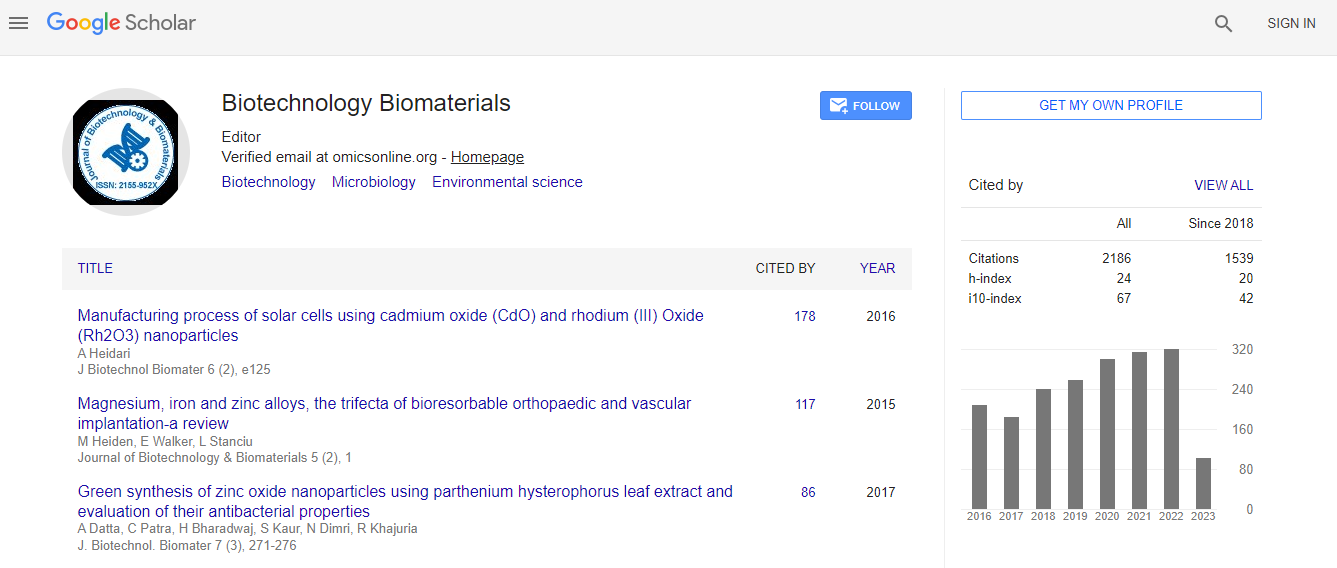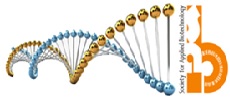Our Group organises 3000+ Global Conferenceseries Events every year across USA, Europe & Asia with support from 1000 more scientific Societies and Publishes 700+ Open Access Journals which contains over 50000 eminent personalities, reputed scientists as editorial board members.
Open Access Journals gaining more Readers and Citations
700 Journals and 15,000,000 Readers Each Journal is getting 25,000+ Readers
Google Scholar citation report
Citations : 3330
Journal of Biotechnology & Biomaterials received 3330 citations as per Google Scholar report
Indexed In
- Index Copernicus
- Google Scholar
- Sherpa Romeo
- Open J Gate
- Genamics JournalSeek
- Academic Keys
- ResearchBible
- China National Knowledge Infrastructure (CNKI)
- Access to Global Online Research in Agriculture (AGORA)
- Electronic Journals Library
- RefSeek
- Hamdard University
- EBSCO A-Z
- OCLC- WorldCat
- SWB online catalog
- Virtual Library of Biology (vifabio)
- Publons
- Geneva Foundation for Medical Education and Research
- Euro Pub
- ICMJE
Useful Links
Recommended Journals
Related Subjects
Share This Page
Rescuing apoptotic neurons from Alzheimer├ó┬?┬?s disease using wheat germ agglutinin-conjugated and cardiolipin-conjugated liposomes with encapsulated nerve growth factor and curcumin
8th Euro Biotechnology Congress
Yung-Chih Kuo and Ching-Chun Lin
National Chung Cheng University, Taiwan
ScientificTracks Abstracts: Biotechnol Biomater
Abstract
Liposomes with Cardiolipin (CL) and Wheat Germ Agglutinin (WGA) were developed to permeate the Blood├ó┬?┬?Brain Barrier (BBB) and treat Alzheimer├ó┬?┬?s disease. WGA-conjugated and CL-incorporated liposomes (WGA-CL-liposomes) were employed to transport Nerve Growth Factor (NGF) and Curcumin (CUR) across a monolayer of human brain-microvascular endothelial cells regulated by human astrocytes and to protect SK-N-MC cells against apoptosis induced with ├?┬▓-amyloid1-42 (A├?┬▓1-42) fibrils. An increase in the CL mole percentage in lipids increased the liposomal diameter, absolute value of zeta potential, entrapment efficiency of NGF and CUR, release of NGF, biocompatibility and viability of SK-N-MC cells with A├?┬▓1- 42, but decreased the atomic ratio of nitrogen to phosphorus and the release of CUR. In addition, an increase in the WGA concentration for grafting enhanced the liposomal diameter, atomic ratio of nitrogen to phosphorus and permeability for NGF and CUR across the BBB, but reduced the absolute value of zeta potential and biocompatibility. WGA-CL-liposomes carrying NGF and CUR can be promising colloidal delivery carriers to target the BBB and inhibit neurotoxicity for future clinical application.Biography
Yung-Chih Kuo is a Professor at the Department of Chemical Engineering, National Chung Cheng University. His research interests are focused on biomaterials, drug delivery system, tissue engineering, blood–brain barrier, stem cell differentiation, nerve regeneration, cancer therapy, Alzheimer’s disease treatment, biophysics and colloid and interface science. In these fields, he has authored or co-authored over 100 SCI journal papers. He won Young Scholar Award in 2003 and Outstanding Research Award during 2010-13. He is also an Associate Editor of Journal of the Taiwan Institute of Chemical Engineers (Impact factor 2.637) and an Editorial Board Member in 11international journals.
Email: chmyck@ccu.edu.tw

 Spanish
Spanish  Chinese
Chinese  Russian
Russian  German
German  French
French  Japanese
Japanese  Portuguese
Portuguese  Hindi
Hindi 
